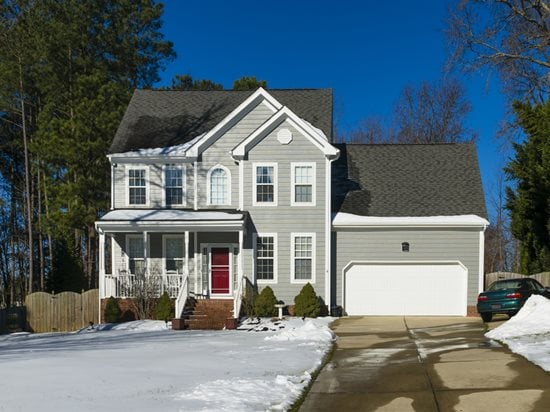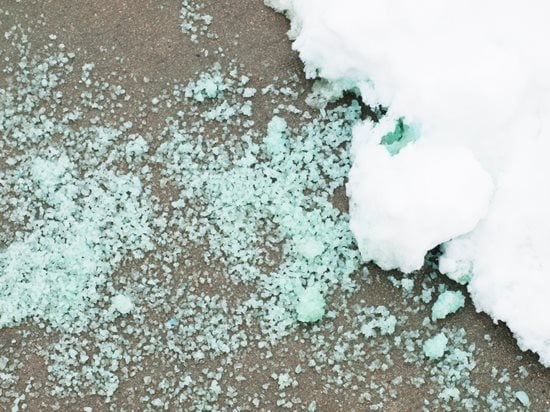- Staining Concrete
- Stamped Concrete
- Concrete Overlays
- Concrete Resurfacing
- Concrete Polishing
- Concrete Dyes
- Colored Concrete
- Indoor Concrete
- Concrete Floors
- Concrete Countertops
- Garage Floor Coatings
- Furniture, Sinks, Fire Bowls
- Basement Floors
- Outdoor Concrete
- Concrete Patios
- Concrete Driveways
- Concrete Pool Decks
- Outdoor Kitchens & Counters
- Outdoor Fireplace
- Concrete Walkways
- Concrete Pavers
- Concrete Walls
- Repair & Maintenance
- Foundation Repair
- Concrete Crack Repair
- Concrete Sealers
- Building with Concrete
- Concrete Homes
- Concrete Basements
- Decorative Concrete
- Fire Resistant
6 Tips to Winterize Your Concrete Driveway, Patio or Walkway
Take these steps before winter arrives to prevent damage to concrete driveways, patios and sidewalks.When you’re putting together a checklist in the fall of the things you need to do to winterize your home, you’re likely to focus on fixing the roof and sealing drafty windows rather than taking care of your exterior concrete. But depending on where you live, winter’s frigid temperatures, ice, and snow can also ravage unprotected concrete, whether it’s a driveway, sidewalk or patio. Like the other important elements of your home, the ideal time to maintain and protect your concrete is before winter arrives. Making these preparations in advance will not only help to preserve the appearance of your concrete, but also potentially save you hundreds of dollars in repair costs in the spring.
Find concrete contractors near me
Remember that concrete is porous.
Although properly installed concrete slabs are extremely durable, they all share one common vulnerability: They are porous and can absorb moisture. That’s not a problem most of the year, but in winter, when temperatures plunge, moisture that seeps into the pores of the concrete can freeze and expand, creating pressure. Over time, the expansive pressure from repeated cycles of freezing and thawing can cause the surface of the concrete to spall, or break away, exposing the coarse aggregate. A concrete surface with existing cracks is at even greater risk of damage because water can enter the cracks and exert enough pressure upon freezing to cause them to widen.
Inspect for damage and make the needed repairs.
The first step and most important step in winterizing your concrete is to inspect it closely for any damage. When left untreated, even a small crack in a concrete slab can turn into a big problem, so it’s vital to repair cracks before winter arrives. If the crack is narrow (about 1/8 inch), it may be something you can fix yourself using a flexible crack sealant that will remain bonded to the concrete as the temperatures rise and fall. If the crack is wider than that, have it looked at by a contractor to make sure it’s not a more serious issue that could affect the integrity of your concrete. Learn more about fixing cracks in concrete driveways and other slabs.
If you concrete is showing signs of spalling, exposure to freeze-thaw cycles will only make it worse. Applying a sealer is a great way to protect the concrete from further deterioration, but if the damage is significant, you may need to resurface the concrete with an overlay (see How to Repair Spalling Concrete).
Seal (or reseal) the surface.
Once cracks and other damage have been repaired, the next step is to apply a penetrating sealer to your concrete to prevent moisture from melting ice and snow from soaking into the pores. A good sealer will also protect your concrete from stains, abrasion, and deicing salts. Applying a concrete sealer does not require expensive equipment or special skills, so you can often tackle the project yourself (see How to Apply Concrete Sealer).
Sealers designed specifically for winter protection include:
- Intraguard from W.R. Meadows
- Gem-Guard SB from Brickform
While sealing your exterior concrete is essential to protecting it from moisture and weather exposure, it’s not something you need to do every year. Depending on the type of sealer used and exposure conditions, you can sometimes wait three years or longer between sealer applications. If this is a project that needs to be added to your concrete winter care list, be sure to schedule it for early fall, before the temperatures drop. As a general rule, air temperatures should be above 50° F when applying most concrete sealers.
Tip: Although concrete patios aren’t typically exposed to deicing salts, like concrete driveways and sidewalks, they are still porous and will absorb water if left unsealed. Applying a sealer to your concrete patio will help prevent the ugly surface spalling and scaling that can occur when water is absorbed into the concrete and expands after it freezes.
Correct drainage problems.
Concrete slabs that don’t drain properly can cause water to pool from melting snow and ice, which can aggravate cracking and spalling. It can become a safety issue as well because the water will create slick spots when it refreezes.
Although clearing the snow regularly from your concrete can help alleviate ice buildup, it won’t solve a serious drainage problem. If your concrete slab has significant low spots where the water collects, consider angling or sloping it slightly so the water will run off the surface. One way to accomplish this is by slabjacking, which can lift the slab to the proper pitch by the injection of a filler material underneath it. If your landscape prevents you from pitching the slab to allow for natural water runoff, your concrete contractor can install an in-slab drainage system with gravel-filled channels to carry the water away. Learn more about concrete drainage options that prevent standing water.
Stock up on the right ice melt products.
Using deicers on a concrete driveway or sidewalk in the winter is often necessary to prevent slip-and-fall accidents. But because ice melts force the thawing and refreezing of moisture, they can often lead to surface scaling and spalling. Products containing ammonium nitrates and ammonium sulphates are especially harmful because they will attack the concrete chemically. Instead, look for ice melts that that are less corrosive, such as calcium chloride, magnesium chloride, or calcium magnesium acetate. For more information, read How to Melt Ice on Concrete.
Tip: Avoid the use of any deicers the first winter after concrete placement, since new concrete is more susceptible to their harmful effects. As an alternative, use sand or volcanic granules. These natural abrasives won’t actually melt ice or snow, but they will improve traction and help prevent slips and falls.
Give your concrete pavers winter protection, too.
Like poured-in-place concrete, decorative concrete pavers can also benefit from cold-weather protection to prevent the damaging effects of winter, such as sealing to prevent moisture intrusion, releveling to correct any drainage problems, and using the right types of ice melt products.
If your concrete pavers have settled in spots over time, they can easily be reset with no noticeable patchwork. Simply remove the affected pavers, regrade and recompact the subbase, and then reinstall them. Before winter arrives, you should also refill the joints between pavers with a polymeric sand, which contains a special additive that binds and hardens the sand to help prevent erosion and keep your pavers from shifting.
RELATED:
Pouring Concrete in Cold Weather
Maintaining Concrete






